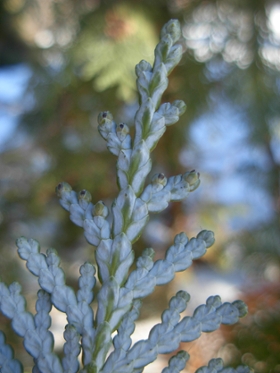Endangered conifers

Two coniferous tree species in the collection are threatened with extinction in their native habitat: Korean arborvitae (Thuja koraiensis) and dragon spruce (Picea asperata).
Korean arborvitae arrived at the Arboretum in 1970, misidentified (but having a name with an important clue) as Thuja occidentalis 'Koreana'. It grew into a multi-stemmed tree with spreading basal branches, cinnamon-coloured peeling bark, and an identifying and distinctive under-leaf colour: chalky white.
Korean arborvitae is listed as vulnerable in the IUCN Red List of Threatened Species. It is declining from deforestation in its limited native habitat of mountain slopes of the Korean peninsula and adjacent parts of China. It is estimated that only 250 to 1000 mature, reproducing trees exist in the wild, and this number is decreasing.
The original Korean arborvitae specimen in the Arboretum is often overlooked in the row of eastern white cedar cultivars, as it has declined in vigour since the flooding events of 2010. A healthy younger specimen, a clone of the original, is now growing on the west end of the arboretum. Korean arborvitae is rare in cultivation; our specimen appears to be the only survivor of all of the test sites of the Prairie Regional Trials for Woody Ornamentals experiment.
Dragon spruce was planted in the collection in 1967. It is a stout tree with massive lower branches, prickly foliage, and large cones.
Dragon spruce is listed as vulnerable in the IUCN Red List of Threatened Species. It occurs in the high mountains and riverbanks of west-central China, where it is declining in numbers. Logging and use in the production of aromatic oils and resin has contributed to the decline of the natural population. In the wild this species may reach 45 metres in height, with a diameter of up to 1 metre.

